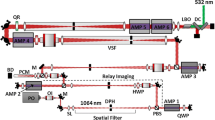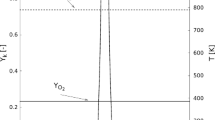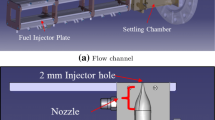Abstract
The problem of measuring mixture fraction (defined here as the fractional part of mass originating from the exhaust gas jet) during the mixing of an unsteady hot exhaust gas jet impinging into a quiescent premixed hydrogen/air mixture is addressed. The diagnostic method is based on planar Laser-Induced Fluorescence of nitric oxide (NO) that is seeded to the hot jet and used as a tag for mixture fraction. The research work presented in this paper focusses on the analytical and experimental data employed for the estimation of mixture fraction using NO as a tracer. Since the NO LIF-signal does not solely depend on the amount of NO, but also on temperature and overall chemical composition, additional information is normally required to transform LIF-signals into mixture fraction values. To provide this additional information, the concept of reduced state spaces is applied: Correlations between state variables (temperature and species) are exploited to establish relationships between the measured signal and the mixture fraction. Simple numerical model simulations are used in combination with spectroscopic calculations to check for correlations between NO-LIF signal and mixture fraction. The result is that sharp correlations between NO-LIF signals and mixture fraction exist, provided that chemical reactions have not yet significantly influenced the flow. These correlations display only little sensitivity with respect to changes of the jet temperature, amount of NO seeded to the jet, and jet velocity. Measurements of NO-LIF were then performed for a non-reacting case before ignition, and mixture fraction maps were obtained from the measured LIF-signals by exploiting the correlations. The resulting data reveal the different driving forces behind mixing at regions near to the jet tip and at the radial shear layers.
Similar content being viewed by others
References
Djebaili, N., Lisbet, R., Dupré, G., Paillard, C.: Effect of the initial temperature and composition of a hot transient jet on the ignition of H2-air-diluent mixtures. Proc. Combust. Inst. 25, 1539–1545 (1994)
Klausmeyer, U., Beyer, M.: Enhancement of the safety of flameproof containments by clarifying the flame transmission phenomena. In: Proc. of the Int. Symposium on Hazards, Prevention and Mitigation of Industrial Explosions, pp. 7.41–7.52. Bergen, Norway (1996)
Murase, E., Ono, S., Hanada, K., Oppenheim, A.K.: Initiation of combustion by flame jets. Combust. Sci. Technol. 113, 167–177 (1996)
Lee, M.P., McMillin, B.K., Palmer, J.L., Hanson, R.K.: Planar fluorescence imaging of a transverse jet in a supersonic crossflow. J. Propul. Power. 8, 729–735 (1992)
Wolfhard, H.G.: The ignition of combustible mixtures by hot jets. Jet Propuls. 12, 798–804 (1958)
Meyer, J.W., Urtiew, P.A., Oppenheim, A.K.: On the inadequacy of gas dynamic processes for triggering the transition to detonation. Combust. Flame 14, 13–20 (1970)
Phillips, H.: Ignition in a transient turbulent jet of hot inert gas. Combust. Flame 19, 187–195 (1972)
Djebaili, N., Lisbet, R., Dupré, G., Paillard, C.: Ignition of a combustible mixture by a hot unsteady gas jet. Combust. Sci. Technol. 104, 273–285 (1995)
Zheng, X.L., Law, C.K.: Ignition of premixed hydrogen/air by heated counterflow under reduced and elevated pressures. Combust. Flame 136, 168–179 (2004)
Mastorakos, E., Baritaud, T.A., Poinsot, T.J.: Numerical simulations of autoignition in turbulent mixing flows. Combust. Flame 109, 198–223 (1997)
Lewis, B., von Elbe, G.: Combustion, Flames and Explosion of Gases, 3rd edn. Academic Press, Inc., Orlando, Florida (1987)
Fielding, J., Frank, J.H., Kaiser, S.A., Smooke, M.D., Long, M.B.: Polarized/depolarized Rayleigh scattering for determining fuel concentrations in flames. Proc. Combust. Inst. 29, 2703–2709 (2002)
Orlemann, C., Schulz, C., Wolfrum, J.: NO-flow tagging by photodissociation of NO2. A new approach for measuring small-scale flow structures. Chem. Phys. Lett. 307, 15–20 (1999)
Frank, J.H., Lyons, K.M., Marran, D.F., Long, M.B., Stårner, S.H., Bilger, R.W.: Mixture fraction imaging in turbulent nonpremixed hydrocarbon flames. Proc. Combust. Inst. 25, 1159–1166 (1994)
Wolfrum, J.: Lasers in combustion: from basic theory to practical devices. Proc. Combust. Inst. 27, 1–41 (1998)
Kohse-Höinghaus, K., Barlow, R.S., Aldén, M., Wolfrum, J.: Combustion at the focus: laser diagnostics and control. Proc. Combust. Inst. 30, 89–123 (2004)
Eckbreth, A.C.: Laser Diagnostics for Combustion Temperature and Species, 2nd edn. Overseas Publishers Association, Amsterdam (1996)
Rossmann, T., Mungal, M.G., Hanson, R.K.: Nitric-oxide planar laser-induced fluorescence applied to low-pressure hypersonic flow fields for the imaging of mixture fraction. Appl. Opt. 42, 6682–6695 (2003)
Bessler, W.G., Schulz, C., Lee, T., Shin, D.-I., Hofman, M., Jeffries, J.B., Wolfrum, J., Hanson, R.K.: Quantitative NO-LIF imaging in high-pressure flames. Appl. Phys., B 75, 97–102 (2002)
Schiessl, R., Kaiser, S.A., Maas, U., Long, M.B.: The application of reduced state spaces to laser-based measurements in turbulent flames. Proc. Combust. Inst. 32, 887–894 (2009)
Sadanandan, R., Markus, D., Schießl, R., Maas, U., Olofsson, J., Seyfried, H., Richter, M., Aldén, M.: Detailed investigation of ignition by hot gas jets. Proc. Combust. Inst. 31, 719–726 (2007)
Beyer, M.: Über den Zünddurchschlag explodierender Gasgemische an Gehäusen der Zündschutzart “Druckfeste Kapselung”. Fortschrittsberichte VDI, Reihe 21, Nr. 228 (1997)
Warnatz, J., Maas, U., Dibble, R.W.: Combustion, 4th edn. Springer Verlag, Berlin (2006)
Maas, U., Warnatz, J.: Ignition processes in hydrogen-oxygen mixtures. Combust. Flame 74, 53–69 (1988)
Klaus, P., Warnatz, J.: A contribution towards a complete mechanism for the formation of NO in flames. In: Joint Meeting of the Frech and German Section of the Combustion Institute. Mulhouse, France (1995)
Bessler, W., Schulz, C., Sick, V., Daily, J.: A versatile modelling tool for nitric oxide LIF spectra. In: Proceedings of the Third Joint Meeting of the U.S. sections of the Combustion Institute, vol. D33, pp. 1–6 (2003)
Bessler, W.: Quantitative nitric oxide concentration and temperature imaging in flames overa a wide pressure range with laser-induced fluorescence. Ph.D. thesis, University of Heidelberg (2003)
Paul, P.H., Gray, J.A., Durant, J.L., Thoman, J.W.: A model for temperature-dependent collisional quenching of NO A 2Σ + . Appl. Phys., B 57, 249–259 (1993)
Stenlåås, O., Egnell, R., Gogan, A., Sunden, B., Mauss, F.: The Influence of nitric oxide on the Occurrence of Autoignition in the End Gas of Spark Ignition Engines. SAE Paper 2002-01-2699 (2002)
Schelb, D., Braun-Unkhoff, M., Frank, P.: NO-promoted methane ignition at temperatures above 920 K. In: Fifth International Conference on Technologies and Combustion for a Clean Environment, pp. 145–151. Lisbon, Portugal (1999)
Frassoldati, A., Faravelli, T., Ranzi, E.: A wide range modeling study of NO x formation and nitrogen chemistry in hydrogen combustion. Int. J. Hydrogen Energy 31, 2310–2328 (2006)
Laster, W.R., Sojka, P.E.: Autoignition of H2/air - the effect of NO x addition. J. Propuls. Power. 5, 385–390 (1989)
Sadanandan, R., Markus, D., Spilling, M., Schießl, R., Maas, U., Olofsson, J., Seyfried, H., Richter, M., Aldén, M.: Observation of the transmission of gas explosions through narrow gaps using time-resolved laser/Schlieren techniques. In: 11th International Symposium on Loss Prevention and Safety Promotion in the Process Industries, pp. 3245–3252 (2004)
Author information
Authors and Affiliations
Corresponding author
Rights and permissions
About this article
Cite this article
Sadanandan, R., Schießl, R.A., Markus, D. et al. 2D Mixture Fraction Studies in a Hot-Jet Ignition Configuration Using NO-LIF and Correlation Analysis. Flow Turbulence Combust 86, 45–62 (2011). https://doi.org/10.1007/s10494-010-9285-0
Received:
Accepted:
Published:
Issue Date:
DOI: https://doi.org/10.1007/s10494-010-9285-0




